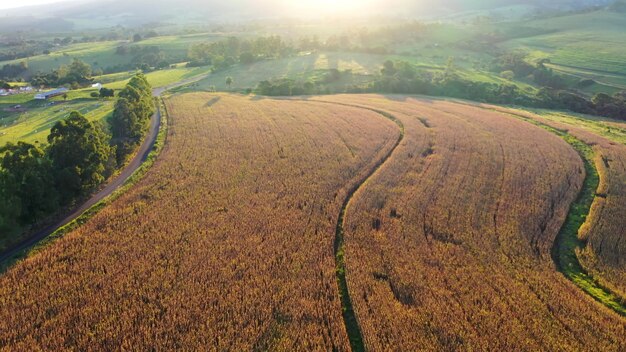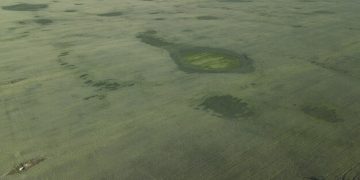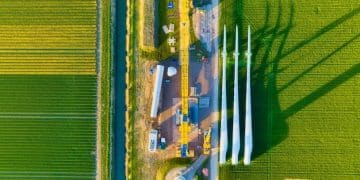Climate Change Impact on US Agriculture: Adapt & Thrive

The unprecedented shifts in climate patterns are profoundly reshaping US agriculture, compelling farmers to adopt innovative strategies for adaptation and resilience to ensure long-term viability and food security.
The profound and accelerating shifts in global weather patterns are demanding urgent attention, especially within critical sectors like agriculture. For American farmers, understanding the impact of climate change on US agriculture: what farmers need to know to adapt and thrive is no longer a distant concern, but rather an immediate imperative impacting operational viability and future prosperity.
Understanding the Climate Challenge in US Agriculture
Climate change presents a multifaceted challenge to the intricate systems of US agriculture, manifesting through a variety of environmental shifts. Farmers across the nation are already witnessing these changes firsthand, from erratic rainfall patterns to more frequent extreme weather events. These aren’t just minor inconveniences; they represent fundamental shifts in the conditions that have historically defined agricultural practices.
Rising Temperatures and Shifting Growing Seasons
One of the most direct impacts of climate change is the consistent rise in average temperatures. This warming trend directly affects crop development cycles, potentially accelerating maturity in some cases while stressing plants in others. The traditional timing for planting and harvesting, often based on decades of historical data, is becoming increasingly unreliable. Farmers must now contend with earlier springs, hotter summers, and sometimes warmer winters, which can extend pest seasons and alter dormancy periods crucial for perennial crops.
- ☀️ Increased heat stress on crops and livestock.
- 🗓️ Altered planting and harvesting windows.
- 🐛 Extended pest and disease life cycles.
- 🍎 Impact on chilling hours for fruit trees.
These temperature shifts are not uniform across the vast expanse of the US agricultural landscape. The Midwest might experience prolonged heatwaves, while the Southwest grapples with intense aridity. Such regional variations underscore the need for localized, flexible adaptation strategies rather than a one-size-fits-all approach. Understanding these micro-climates and their specific vulnerabilities is paramount for effective planning.
Extreme Weather Events: Frequency and Intensity
Beyond gradual temperature changes, the agricultural sector is increasingly at the mercy of extreme weather. Droughts are becoming more severe and prolonged in certain regions, depleting crucial water reserves and leading to widespread crop failures. Conversely, other areas are experiencing torrential downpours and unprecedented flooding, which can wash away topsoil, damage infrastructure, and drown crops. The destructive power of hurricanes, tornadoes, and hailstorms also poses a growing threat, leading to significant financial losses and disrupting supply chains.

The increased frequency and intensity of these events leave farmers with little time to recover, often pushing their operational resilience to breaking point. Crop insurance, while helpful, rarely covers the full spectrum of losses, and the psychological toll on farming communities can be immense. Building resilience into farm operations means not only preparing for these events but also developing recovery plans that enable swift and effective rebuilding.
In essence, the climate challenge is redefining the very foundation of US agriculture. It demands a proactive, informed, and adaptive mindset from every farmer committed to sustaining their livelihood and contributing to national food security. The coming sections will explore specific impacts and actionable strategies to confront these realities.
Direct Impacts on Crop Production and Yields
The intricate dance between climate and crop growth means that any disruption in environmental conditions inevitably affects agricultural productivity. Farmers are increasingly observing changes in yield, quality, and even the viability of certain crops they have cultivated for generations. These direct impacts pose significant economic threats and challenge the continuity of food production.
Water Scarcity and Irrigation Challenges
Water is the lifeblood of agriculture, and climate change is severely complicating its availability. Regions traditionally sustained by reliable snowmelt are seeing reduced snowpacks, leading to less available water during critical growing periods. Aquifers are being depleted at unsustainable rates due to increased irrigation demands in dryer conditions. This scarcity not only increases the cost of water but also raises significant questions about its long-term availability for agriculture.
Farmers in arid and semi-arid regions are at the forefront of this challenge. They are forced to make difficult decisions about which crops to grow, how much land to cultivate, and when to irrigate, all while facing diminishing returns on their water investments. The specter of water restrictions looms large, threatening the agricultural output of some of the nation’s most productive areas. Addressing water scarcity requires both immediate conservation measures and long-term infrastructure and policy changes.
Soil Health Degradation and Erosion
Healthy soil is the foundation of productive farming, but climate change impacts its integrity. Intense rainfall events can lead to severe soil erosion, washing away nutrient-rich topsoil crucial for crop growth. Prolonged droughts can cause soil to become compacted and lose organic matter, reducing its capacity to retain water and nutrients. Increased temperatures can also accelerate the decomposition of organic matter, further depleting soil fertility.
Degraded soil health directly translates to reduced yields and increased reliance on synthetic fertilizers, which can have their own environmental footprint. Restoring and maintaining soil health through practices like no-till farming, cover cropping, and efficient nutrient management is critical not just for productivity but also for absorbing carbon and enhancing water retention. These practices are becoming indispensable tools in the farmer’s fight against climate change impacts.
Pest, Disease, and Weed Pressure
Warmer temperatures and altered precipitation patterns are creating more favorable conditions for agricultural pests, diseases, and weeds. Many insect pests can complete more life cycles in a single season, leading to larger populations and greater crop damage. The geographical ranges of certain pests and diseases are also expanding into previously unaffected areas, introducing new threats to local ecosystems and farm operations.
- 🦟 Proliferation of insect pests due to warmer winters.
- 🦠 Emergence of new plant pathogens in changing climates.
- 🌿 Increased resistance in weeds to herbicides.
- 🌍 Geographical expansion of invasive species.
Farmers are finding themselves in a constant battle to protect their crops, often resorting to increased use of pesticides, which can have environmental and economic consequences. Integrated Pest Management (IPM) strategies, which combine biological, cultural, physical, and chemical tools to minimize risks, are becoming more vital than ever. Adapting to these biological shifts requires continuous monitoring, research, and collaborative efforts across the agricultural community.
The direct impacts on crop production are profound, forcing farmers to re-evaluate every aspect of their operations. From managing precious water resources to safeguarding soil health and battling emerging biological threats, the challenges are significant, yet innovation and adaptation offer pathways forward.
Livestock and Animal Agriculture Vulnerabilities
While often focused on crops, the livestock sector is equally vulnerable to the effects of climate change, facing unique challenges that impact animal health, productivity, and the economic well-being of ranchers and producers. The interplay of rising temperatures, water scarcity, and feed availability creates a complex and challenging environment for animal agriculture.
Heat Stress and Animal Health
Increased frequency and intensity of heatwaves pose a serious threat to livestock across the US. Animals, particularly cattle, poultry, and swine, are susceptible to heat stress, which can lead to reduced feed intake, decreased growth rates, lower milk production, and diminished reproductive efficiency. In severe cases, extreme heat can result in direct mortality, causing significant economic losses for producers.
Managing heat stress requires proactive measures. This includes providing adequate shade and ventilation, ensuring access to abundant clean water, and potentially altering feeding schedules to cooler parts of the day. Innovations in cooling systems and genetic selection for heat-tolerant breeds are also gaining traction. The well-being of livestock is not only an ethical concern but directly impacts the profitability and sustainability of animal agricultural operations.
Forage and Feed Challenges
Climate change impacts the availability and quality of pastureland and feed crops, which are fundamental to livestock production. Droughts reduce forage growth, forcing ranchers to reduce herd sizes or incur additional costs for supplemental feed. Flooding can destroy hayfields and make pastures unusable, further exacerbating feed shortages.
- 🌾 Reduced pasture availability due to drought.
- 📦 Increased cost of purchased feed.
- 📉 Lower nutritional quality of some forage.
- 🚫 Limited access to grazing areas after extreme weather.
The volatility in feed prices and availability creates significant financial instability for livestock producers. Diversifying feed sources, improving pasture management practices to enhance resilience, and exploring alternative forages are critical strategies. Long-term planning, including strategic destocking during severe droughts, becomes a necessary, albeit difficult, consideration.
Water Access and Quality for Animals
Just as water scarcity affects crop production, it directly impacts livestock. Ensuring sufficient and clean drinking water for large herds is a growing concern, especially in drought-prone regions. Reduced water availability can lead to animals consuming water from less desirable or contaminated sources, potentially exposing them to diseases and toxins. The quality of water can also be compromised by increased temperatures, fostering algal blooms or concentrating pollutants.
Producers must invest in water infrastructure that is resilient to climate extremes, such as deeper wells, rainwater harvesting systems, and efficient watering points. Monitoring water quality regularly is also essential to safeguard animal health. The availability of reliable water sources will increasingly dictate the viability of livestock operations in certain areas, underscoring the need for careful water resource management.
The resilience of the US livestock sector hinges on its ability to adapt to these evolving environmental pressures. Implementing robust management strategies, investing in new technologies, and focusing on animal welfare will be crucial for maintaining productive and sustainable animal agriculture in a changing climate.
Adaptation Strategies for a Resilient Future
Given the pervasive impacts of climate change, adaptation is not merely an option but a necessity for the longevity and profitability of US agriculture. Farmers are actively implementing a range of strategies, from technological advancements to traditional wisdom, to build resilience into their operations. These adaptations often require significant investment, but the long-term benefits of reduced risk and enhanced sustainability are becoming increasingly clear.
Embracing Precision Agriculture Technologies
Precision agriculture leverages technology to optimize resource use and improve decision-making. Tools like GPS-guided machinery, remote sensing (drones and satellites), and real-time data analytics allow farmers to apply water, fertilizers, and pesticides with unprecedented accuracy. This minimizes waste, reduces environmental impact, and enhances resource efficiency, crucial in times of scarcity.
Variable rate irrigation, for instance, tailors water application to the specific needs of different parts of a field, preventing over-watering in some areas and under-watering in others. Similarly, soil sensors provide continuous data on moisture levels and nutrient content, enabling proactive adjustments. The initial investment in these technologies can be substantial, but the long-term savings in inputs and increased yields often justify the cost, making farms more efficient and less vulnerable to climate variability.
Implementing Water Conservation Practices
Efficient water management is paramount. Farmers are adopting various techniques to maximize every drop: drip irrigation and micro-sprinklers deliver water directly to plant roots, significantly reducing evaporation and runoff compared to traditional flood irrigation. No-till or minimum-till farming practices help retain soil moisture by disturbing the soil less, enhancing its organic matter content and improving water infiltration.
- 💧 Drip and micro-sprinkler irrigation systems.
- 🌱 No-till and conservation tillage methods.
- 🌧️ Rainwater harvesting and runoff management.
- 🧪 Soil moisture sensors and smart irrigation scheduling.
Beyond technology, strategic crop rotation with water-efficient crops and planting drought-tolerant varieties are also vital. Investing in advanced monitoring systems that provide real-time information on soil moisture and weather forecasts helps farmers make informed decisions about when and how much to irrigate, ensuring that water is used as judiciously as possible.
Diversifying Crops and Livestock
Monoculture can be risky in a changing climate, making entire operations vulnerable to a single extreme event or a new pest. Diversifying the types of crops grown or livestock raised can spread risk and provide alternative income streams. This might involve introducing new, climate-resilient crop varieties adapted to projected local conditions, such as heat-tolerant grains or drought-resistant legumes.
For livestock producers, diversifying animal breeds to include those known for heat tolerance or disease resistance can enhance herd resilience. Moreover, integrating crop and livestock operations, often referred to as mixed farming, can create synergistic benefits, such as using livestock manure as fertilizer for crops, reducing reliance on external inputs and building a more robust, adaptive farm ecosystem.
Soil Health Improvement and Carbon Sequestration
Healthy soil is a powerful climate buffer. Practices that enhance soil health, such as cover cropping, crop rotation, and composting, increase organic matter content. This improves the soil’s capacity to retain water, cycle nutrients, and sequester carbon from the atmosphere. Carbon sequestration in soils not only mitigates climate change but also makes the soil more fertile and resilient to drought and erosion.
Agroforestry, which integrates trees and shrubs into agricultural landscapes, is another strategy gaining traction. Trees can provide shade for livestock, protect crops from wind, and enhance biodiversity, all while storing carbon. Investing in soil health is a long-term strategy that provides multiple benefits, cementing the foundation for resilient and sustainable agricultural production.
These adaptation strategies represent proactive steps farmers can take to safeguard their livelihoods. While each farm is unique, the overarching principle is to foster resilience, leverage innovation, and embrace practices that build a more sustainable and adaptable agricultural system capable of thriving in a volatile climate.
Policy Support and Financial Assistance
The scale of climate change impacts on US agriculture necessitates more than individual farm adaptations; it requires robust policy support and comprehensive financial assistance mechanisms. Government programs, research initiatives, and private sector partnerships play a crucial role in empowering farmers to adopt climate-smart practices, share knowledge, and mitigate economic risks.
Federal and State Programs for Climate Resilience
Various federal and state programs are designed to assist farmers in building climate resilience. These include conservation programs that offer financial incentives for adopting practices like conservation tillage, cover cropping, and nutrient management. The USDA’s Natural Resources Conservation Service (NRCS) provides technical and financial assistance for implementing these beneficial practices.
Additionally, disaster relief programs provide critical support in the aftermath of extreme weather events, helping farmers recover and rebuild. However, there is a growing recognition that these programs need to shift from reactive disaster response to proactive risk management and adaptation, providing long-term support for climate-resilient infrastructure and practices. Advocacy for robust farm bill legislation that prioritizes climate adaptation is also essential.
Crop Insurance and Risk Management Tools
Crop insurance remains a cornerstone of financial risk management for farmers. However, as climate risks intensify, existing insurance products may need to evolve to adequately cover the increasing frequency and severity of losses from drought, floods, and other extreme events. Exploring new insurance mechanisms that incentivize adaptation, such as discounted premiums for climate-smart practices, could provide stronger incentives for farmers to adopt resilient measures.
Beyond traditional insurance, other risk management tools include diversified income streams, robust farm business planning, and participation in commodity hedging programs. The goal is to reduce financial vulnerability to climate-related disruptions, ensuring that even if yields are impacted, the farm remains economically viable. Education and outreach on these complex financial instruments are vital for broad adoption.
Research and Development in Climate-Resilient Agriculture
Continued investment in agricultural research is paramount. Universities, government agencies, and private companies are actively working on developing climate-resilient crop varieties and livestock breeds that can withstand heat, drought, and new pest pressures. This includes genetic advancements, but also research into novel farming systems, such as vertical farms or controlled environment agriculture, that offer greater control over growing conditions.
Research also extends to improving soil health, water management techniques, and understanding complex ecosystem interactions. Funding for agricultural extension services is key, as these services act as vital bridges, translating cutting-edge research into practical, on-farm applications. Collaborations between scientists, policymakers, and farmers ensure that research is relevant and effectively implemented.
Market Incentives and Sustainable Supply Chains
The market itself can drive climate-smart agriculture. Consumers are increasingly demanding sustainably produced food, creating opportunities for farmers who adopt eco-friendly practices. Certification programs and consumer labeling can provide market advantages for products grown with climate resilience in mind. Furthermore, working with supply chain partners who are committed to sustainability can help spread best practices and create a more resilient food system from farm to fork.
Incentives for carbon farming, where farmers are compensated for sequestering carbon in their soils, represent another promising avenue. These market-based mechanisms can provide additional revenue streams, further encouraging the adoption of practices that benefit both the farm and the environment. Leveraging these policy, financial, and market tools is critical to scaling up climate adaptation efforts across US agriculture.
Monitoring and Predicting Future Climate Trends
Effective adaptation in agriculture hinges on the ability to anticipate future climate conditions. While perfect foresight is impossible, advances in climate science and agricultural modeling provide increasingly sophisticated tools for monitoring current trends and projecting future scenarios. This predictive capability enables farmers and policymakers to make more informed, proactive decisions.
Advancements in Climate Modeling
Climate models, powered by supercomputers, integrate vast amounts of data on atmospheric, oceanic, and land surface processes to simulate future climate states. These models are constantly improving in resolution and accuracy, allowing scientists to develop more localized projections of temperature, precipitation, and extreme events. Farmers can access aggregated data and forecasts through various platforms, although interpreting these complex models for specific farm management decisions remains a challenge.
The development of seasonal and sub-seasonal forecasts offers a critical advantage, helping farmers plan for irrigation needs, planting dates, and potential pest outbreaks with greater confidence. While uncertainties persist, especially in long-term projections, climate models provide the best available science to guide adaptation efforts, moving agriculture from a reactive to a more proactive stance.
Data Analytics and On-Farm Monitoring
Beyond broad climate models, granular, on-farm data collection is invaluable. Sensors can monitor soil moisture, temperature, and nutrient levels in real-time. Drones and satellite imagery can provide detailed insights into crop health, water stress, and pest infestations across vast fields. When combined with historical yield data and local weather records, these datasets can be analyzed to identify trends, optimize resource use, and predict future challenges.
- 📊 Real-time soil moisture and temperature data.
- 🛰️ Satellite and drone imagery for crop health assessment.
- 📈 Predictive analytics for pest and disease outbreaks.
- ☁️ Microclimate monitoring at individual farm level.
The advent of artificial intelligence (AI) and machine learning (ML) is further enhancing this capability, allowing for patterns to be identified in complex datasets that might be invisible to the human eye. This data-driven approach empowers farmers to make highly localized and timely management decisions, reducing risks and increasing efficiency in the face of variable climate conditions.
Collaboration with Climate Scientists and Extension Services
The effective translation of climate science into actionable agricultural practices requires strong collaboration. Climate scientists can help farmers understand the specific regional implications of climate change, while extension services play a vital role in disseminating this knowledge in practical, accessible formats. Workshops, field days, and online resources provide platforms for farmers to learn about the latest climate projections and adaptation strategies.
Establishing feedback loops, where farmers share their observational data and practical experiences with scientists, is also crucial. This ensures that research remains grounded in real-world challenges and that adaptation strategies are continually refined based on their effectiveness in the field. This community of practice fosters innovation and collective resilience across the agricultural sector.
Developing Farm-Specific Climate Action Plans
Ultimately, the goal of monitoring and prediction is to enable farmers to develop tailored climate action plans for their specific operations. These plans would assess vulnerabilities, identify potential risks, and outline specific adaptation strategies, including changes in crop varieties, irrigation schedules, or livestock management. Such plans are dynamic, requiring continuous review and adjustments based on new climate information and on-farm results.
A farm-specific plan might integrate diversified crop rotations, investment in more efficient irrigation, or a shift towards regenerative agricultural practices. This forward-looking approach, informed by the best available science and real-time data, is essential for ensuring the long-term viability and sustainability of individual farms within the broader context of a changing climate.
The Role of Farmer Innovation and Community Resilience
While external support and scientific advancements are vital, the ingenuity and collective action of farmers themselves are perhaps the most powerful forces driving adaptation in US agriculture. Farmers have a long history of innovation, constantly seeking better ways to steward their land and ensure productivity. This innate adaptability, combined with strong community ties, forms the bedrock of climate resilience.
Peer-to-Peer Learning and Knowledge Sharing
Farmers often learn best from each other. Formal and informal farmer networks, local agricultural cooperatives, and online forums provide invaluable platforms for sharing experiences, successes, and failures in adapting to climate challenges. When one farmer discovers a new drought-resistant variety or an efficient irrigation technique, sharing that knowledge rapidly accelerates the adoption of best practices across the community.
Field days hosted by innovative farmers, workshops organized by local extension offices, and farmer-led research initiatives all contribute to a vibrant ecosystem of knowledge exchange. This peer-to-peer learning not only disseminates practical solutions but also fosters a sense of collective purpose in confronting shared environmental challenges.
Entrepreneurial Spirit and Agritech Adoption
The entrepreneurial spirit inherent in farming drives much of the industry’s innovation. Many farmers are early adopters of emerging technologies, such as advanced sensors, data analytics platforms, and automation tools, recognizing their potential to enhance efficiency and resilience. This willingness to experiment and invest in new solutions positions them at the forefront of climate adaptation.
Furthermore, farmers often innovate on their own, modifying existing equipment or developing novel approaches to suit their unique operational needs and local environmental conditions. This bottom-up innovation is critical, as it provides practical, field-tested solutions that can then be scaled up or adapted by others. The growth of the Agri-Tech sector is largely fueled by this demand from progressive farmers seeking cutting-edge solutions.
Building Strong Local Food Systems
Climate change highlights the importance of diversified, localized food systems. Shorter supply chains, direct-to-consumer sales, and community-supported agriculture (CSA) initiatives can enhance resilience by reducing reliance on long-distance transportation and large-scale, vulnerable infrastructure. When local food systems are strong, communities are better able to weather disruptions caused by climate impacts further afield.
Investing in local food infrastructure—such as regional processing facilities, farmers’ markets, and food hubs—empowers farmers to connect directly with consumers and provides greater control over their economic destiny. Strong local economies that support agriculture can also provide a vital safety net during challenging periods, reinforcing community resilience.
Advocacy and Collective Action
Farmers are increasingly engaging in collective action and advocacy to drive policy changes that support climate adaptation. Producer organizations, agricultural associations, and grassroots movements are amplifying farmers’ voices, ensuring that their needs and perspectives are heard by policymakers. This collective advocacy is essential for securing funding for research, developing supportive legislation, and promoting equitable climate policies.
By working together, farmers can influence the broader agricultural landscape, advocating for practices and policies that build resilience not just for their own operations but for the entire sector. The blend of individual innovation and strong community bonds positions US agriculture to navigate the complexities of a changing climate with resilience and determination.
| Key Point | Brief Description |
|---|---|
| ☀️🌡️ Rising Temperatures | Lead to altered growing seasons, increased heat stress on crops and livestock, and extended pest cycles. |
| 💧 Drought & Flooding | Cause water scarcity, soil erosion, and direct crop damage, impacting yields and resource availability. |
| 💡 Adaptation Strategies | Involve precision agriculture, water conservation, crop diversification, and soil health improvements. |
| 🤝 Policy & Innovation | Government support, R&D, and farmer-led innovation are crucial for building long-term resilience. |
Frequently Asked Questions About Climate Change and US Agriculture
Extreme weather events like droughts, floods, and severe storms cause direct damage to crops, livestock, and infrastructure. They lead to significant financial losses, disrupt planting and harvesting schedules, and can erode valuable topsoil. Farmers face increased uncertainty and higher operational costs.
Precision agriculture technologies such as GPS-guided machinery, remote sensing (drones, satellites), and soil moisture sensors optimize resource use. Variable rate irrigation, AI-driven data analytics, and climate modeling tools also assist farmers in making data-backed decisions for efficiency and resilience.
Climate change degrades soil health through increased erosion from intense rainfall, loss of organic matter in droughts, and altered microbial activity due to temperature shifts. This reduces fertility, water retention, and carbon sequestration capacity, making soil less productive and resilient.
Yes, federal and state programs, like those from the USDA’s NRCS, offer financial and technical assistance for adopting conservation practices. Disaster relief programs provide aid post-event, while ongoing research and development initiatives aim to create more climate-resilient farming techniques and crop varieties.
Diversifying crops and livestock reduces vulnerability to single threats. If one crop fails due to specific climate conditions, others might survive. It spreads risk, enhances biodiversity, improves soil health, and can provide alternative income streams, making the farm operation more stable and adaptable long-term.
Conclusion
Navigating the complex interplay of a changing climate and agricultural practices demands a dynamic, informed, and collaborative approach. For US farmers, adapting to these evolving conditions is not merely about survival, but about seizing opportunities for innovation, building stronger communities, and ensuring the continued vitality of the nation’s food supply. By embracing cutting-edge strategies, leveraging policy support, and fostering a spirit of continuous learning, American agriculture can chart a path towards a more resilient and sustainable future, safeguarding both livelihoods and the broader ecosystem.





